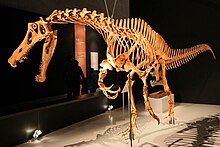Irritator
|
Irritator Temporal range: Early Cretaceous, 110 Ma |
|
|---|---|
 |
|
| Reconstructed skeleton | |
| Scientific classification | |
| Kingdom: | Animalia |
| Phylum: | Chordata |
| Class: | Reptilia |
| Clade: | Dinosauria |
| Order: | Saurischia |
| Suborder: | Theropoda |
| Family: | †Spinosauridae |
| Subfamily: | †Spinosaurinae |
| Genus: |
†Irritator David Martill et al., 1996 |
| Species | |
|
|
| Synonyms | |
|
|
Irritator is a genus of spinosaurid dinosaur that lived in the early Cretaceous Period (Albian stage), around 110 million years ago. Current estimations indicate a length of 8 meters (26 feet). In 2010, Gregory S. Paul gave lower estimations of 7.5 metres and one tonne. It was found in Brazil. Irritator was a theropod with an unusually shaped crest at the rear of its head, and most likely consumed fish.
So far the only fossil that has been found was an 80 centimeter long fossil skull in the Romualdo Member, a layer member of the Santana Formation. This skull strongly resembles the skulls of Suchomimus and Spinosaurus. The genus is often regarded today as identical (synonymous) with Angaturama, which lived in the same time and the same place as Irritator.
The holotype fossil consists only of the front part of the head, which is kept today under the number USP GP/2T-5 in the University of São Paulo. It is characterized particularly by its unusual length and curved lip region, which is strongly compressed laterally. The overall length of the complete head is estimated at approximately 84 centimeters. In the premaxilla, a broken-off tooth with partial tooth crown was recovered. The strongly extended and straight teeth with conical tooth crowns, which are 6 to 40 millimeters long, are singly embedded. This indicates continuous tooth replacement where new teeth were pushed up between the old ones. Judging by the tooth sockets, altogether the premaxilla had seven teeth; the third tooth was the largest.
Irritator was first scientifically described in 1996 by paleontologists Martill, Cruikshank, Frey, Small and Clarke. Its only known fossil, an 80 cm skull discovered in eastern Brazil, was badly obscured by plaster which was added by the commercial fossil-collecting fossil-poachers who illegally sold it (the trade of fossils is prohibited by law in Brazil), in hopes of making the fossil look more complete and valuable. For example, "the posterior portion of the saggital [sic] crest... [was] fabricated by fossil dealers." The buyers were not aware of the modifications to the illegally collected specimen, and it required them a great deal of work to reconstruct the original features — hence the name. Martill et al. (1996) wrote that the generic name Irritator came "from irritation, the feeling the authors felt (understated here) when discovering that the snout had been artificially elongated." The type species is I. challengeri, which honors the character of Professor Challenger in Arthur Conan Doyle's The Lost World.
...
Wikipedia
